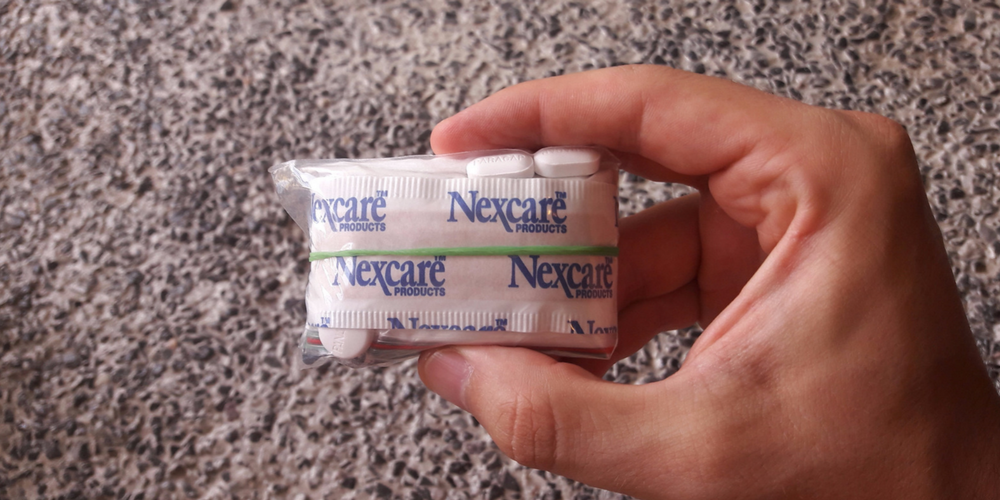Personal locator beacons and satellite messengers can signal for help in emergency situations. These devices range from ones that strictly send out an SOS signal, to ones that also provide two-way messaging services and navigational features.
In this post, we break down the differences between personal locator beacons and satellite messengers and discuss what they are and how they work. We also provide a list of the best personal locator beacons and satellite messengers for 2024 as well as guide you on what to look for, whether you are going on weekend walks in the woods or heading out for a thru-hike.
Table of Contents
Personal Locator Beacons vs. Satellite Messengers
It is essential to have a personal locator beacon or a satellite messenger to signal for help. They can bring assistance when you need help getting out of the woods or can even save your life when you find yourself in a worst case scenario.
![]()
Personal Locator Beacon (left) versus Satellite Messenger (right)
Personal Locator Beacons: send a one-way emergency distress signal.
Personal locator beacons (PLBs) send out a powerful one-way, one-time emergency distress signal that can be pinpointed to anywhere in the world. Once the signal is initiated, there is no turning back - help is coming whether you still need it or not. Consequently, they should only be used in life-and-death scenarios when self-rescue is not possible. There is no messaging feature with a PLB, and no subscriptions are required.
Satellite Messengers: a messaging device for remote two-way communication.
Similar to PLBs, satellite messengers send out an emergency distress signal that can alert authorities of your location. Not only can you request help, but you also can send text messages to search and rescue teams, so they know what gear they need to bring and how quickly they have to get to you. Beside emergency communication, satellite messengers also let you send messages to family and friends and have a tracking feature that allows others to follow your hike.
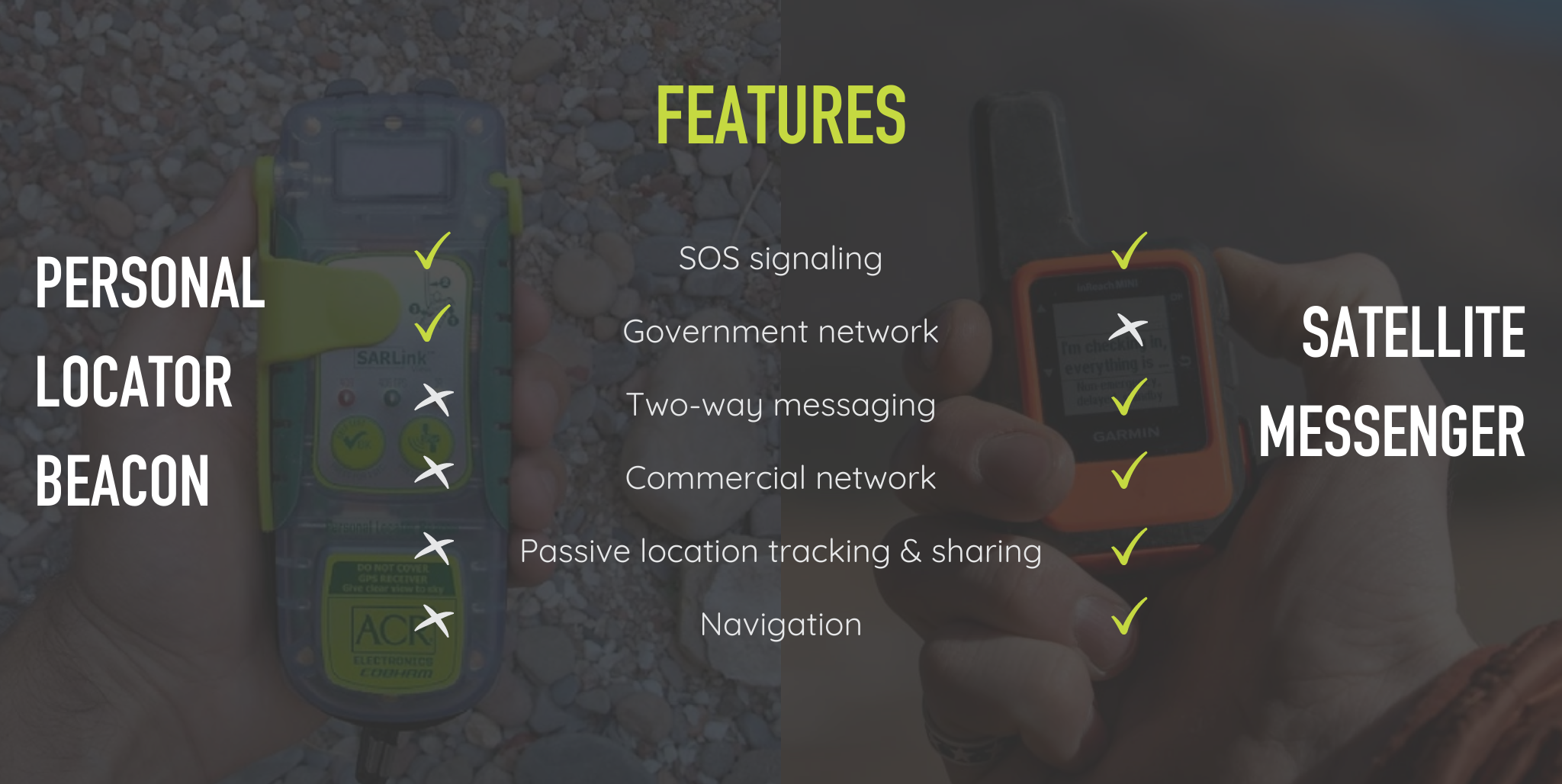
Understanding Personal Locator Beacons
HOW DO PERSONAL LOCATOR BEACONS WORK?
A personal locator beacon has a single purpose - to alert authorities that you need help immediately. The distress signal on a PLB is designed to be easily activated by a person in distress or a bystander who finds an injured or unresponsive person.
-
Step 1: Activating a PLB. The device is activated by extending the antenna to its upright position and then pressing the emergency activation button that is only visible when the antenna is deployed. The antenna should be kept outside with a clear view and pointed to the sky, not buried in a backpack. Depending on the model, this process may also activate an LED strobe that makes it easy to spot someone at night. If you are not sure how to work a PLB, there are usually step-by-step instructions on the device.
-
Step 2: Distress Signal is Sent to a Satellite. When you activate a PLB, it sends out two signals - a powerful digital signal at 406 MHz that is received by the COSPAS-SARSAT international search and rescue satellite system and a low-power analog honing signal at 121.5MHz. If the PLB has GPS, then the 406 MHz distress signal will contain location coordinates that can be used to start a rescue effort as soon as the alert is received. If GPS is not available then the satellite will triangulate the location of the distress call and send along that information as soon as it is available.
![]()
-
Step 3: Distress Call is Received by Ground Center. Once the satellite receives the 406 MHz signal, it immediately sends it to a ground-based communications center that will alert either the AFRCC (Air Force Rescue Coordination Center) for inland rescues or the USCG (United States Coast Guard) for marine calls. These control centers then forward the details to the appropriate Rescue Coordination Center (RCC) in the US or a foreign SAR center if the call is international.
-
Step 4: Ground Center Relays Emergency to Local SAR. The RCC is responsible for initiating the search and rescue effort by contacting local authorities or SAR team(s). These alerts can be issued within minutes of receiving a signal, but it may take an hour or more to assemble a search team and coordinate a rescue mission. If weather conditions are favorable, search teams then hit the ground or the air to look for the origin of the distress signal using the transmitted location data and their knowledge of the area. They also can hone in on a victim using the 121.5 MHz signal that the PLB emits.
 © SNappa2006 (CC BY 2.0)
© SNappa2006 (CC BY 2.0)
WHAT IS THE UIN AND HOW DOES IT HELP?
PLBs not only send a distress signal and location but they also can send the Unique Identifying Number (UIN) of the device. Each device is linked to the owner's profile and provides search and rescue teams with relevant personal information such as a person's age, and known medical conditions. When you purchase a PLB, you are required by law to register the owner information in the NOAA SARSAT database. Registration is free here: www.beaconregistration.noaa.gov. Note owners need to renew their registration every two years or when they transfer ownership of the device.
CAN I RECALL MY ALERT?
If the device is activated by accident, the alarm can be deactivated by pressing and holding the emergency button for five seconds. A false alarm must be reported immediately to the US Air Force Rescue Coordination Center (AFRCC) so the SAR alert can be canceled. Don't test the device by sending a false alert. Each device has a test mode that will communicate with the SARSAT satellite network without sending an alert.
2 TYPES OF SIGNALS: 406 AND 121.5
PLBs emit two distinct signals - a digital distress signal at 406MHz and a honing signal at 121.5 MHz. The 406Mhz transmission carries location data as well as the UIN of the device and initiates a Search and Rescue operation. The 121.5 MHz analog signal is used on the ground by search and rescue team members who carry or fly with equipment that can pinpoint the source of this low-power transmission.
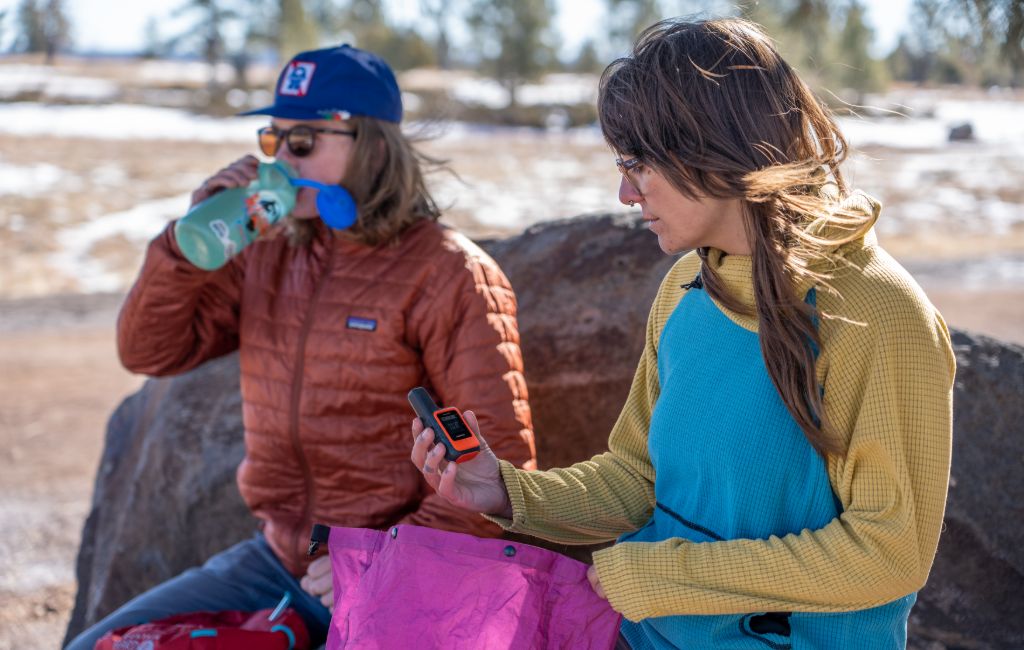
OTHER TYPES OF BEACONS: PLB VS. EPIRB VS. ELT AND DIFFERENCES
There are three major types of beacons -- a personal locator beacon (PLB), an Emergency Position Indicating Radio Beacon (EPIRB) and an Emergency Locator Transmitter (ELT). All three transmit a distress signal at 406 MegaHertz (MHz), but they differ in their intended usage and the type of data they send.
PLBs are the smallest of three, and their size makes them easier to carry than their EPIRB and ELT counterparts. They are meant to be carried by someone who is adventuring on land or near to the shore. EPIRBs are designed for maritime usage especially on vessels that travel more than 2 miles off the coast. They last up to 48 hours and are registered to the boat on which they are installed. ELTs are non-portable units meant to be fitted into an aircraft and are activated when a plane crashes.
HOW LONG WILL PLBs EMIT A SIGNAL? IS IT RELIABLE?
A PLB will emit a signal as long as the battery is operational. PLB batteries are dormant until activated and are required by law to transmit for a minimum of 24 hours. Most PLBs claim to deliver at least 30 hours of continuous SOS signalling.
Like most satellite devices, a PLB needs a clear view of the sky to operate. If you are in the thick woods or a deep cavern, you may have difficulty connecting to a satellite when sending a distress signal. The biggest drawback to a PLB is there is no way to confirm that the SOS was picked up by a satellite and that a rescue mission is underway.
Understanding Satellite Messengers
WHAT IS A SATELLITE MESSENGER?
Satellite Messengers have the SOS feature of a PLB but add on tracking and two-way messaging for users who want to be connected while backcountry exploring. They are ideal for hikers and backpackers who travel to remote areas where there is no mobile phone coverage and want to stay in contact with friends and family at home.

(a map of SPOT's coverage)
HOW DOES A SATELLITE MESSENGER WORK?
Unlike the PLBs which use the government-backed SARSAT satellite network and SAR resources, the satellite messengers use a commercial satellite network (Iridium or Globalstar) and a private sector response center to handle emergency calls. Emergency calls with GPS data are sent to the satellite network and immediately routed to a 24/7 command center. The command center then contacts local SAR to initiate a search and rescue. Because they use commercial systems to provide SOS features and more, the satellite messengers require a monthly or yearly subscription on top of their purchase price.
TWO-WAY MESSAGING
The most significant difference between a PLB and a satellite messenger is messaging. PLBs only emit a distress call and cannot be used for communications. Satellite messengers, on the other hand, can communicate with outside parties using the satellite system. Depending on the model and subscription plan, these messengers can send and receive messages with any mobile phone number or email address. Messages can be pre-configured with blurbs like "I'm OK" or custom texts that provide details about the current situation. The text can be entered directly on the device or through an app on a cellphone that is connected to the satellite messenger. This messaging feature is useful for communicating with loved ones and is indispensable during an emergency. Not only can you get a message confirming that your SOS has been received, but you also can provide details on your location and current situation to rescuers.
![]()
TRACKING AND SOCIAL MEDIA
Besides messaging, Satellite messengers also allow for tracking using GPS. Tracking points are sent via satellite to a website where they are displayed on a map. Family and friends at home can open this map and track a hiker's progress. Hikers also can share their location data on social media allowing fans to follow along with their adventure..
SATELLITE MESSENGER SUBSCRIPTION REQUIREMENTS
Because they provide a smorgasbord of features that use a commercial network, satellite messengers incur a monthly or annual fee above and beyond the initial purchase cost. These fees start at $11.95 a month for a small allotment of messages and climb upwards when you add in unlimited tracking and unlimited messaging. Each device must be registered and activated with a service provider to work, but there is no law requiring an owner to enter their personal information into a government database.
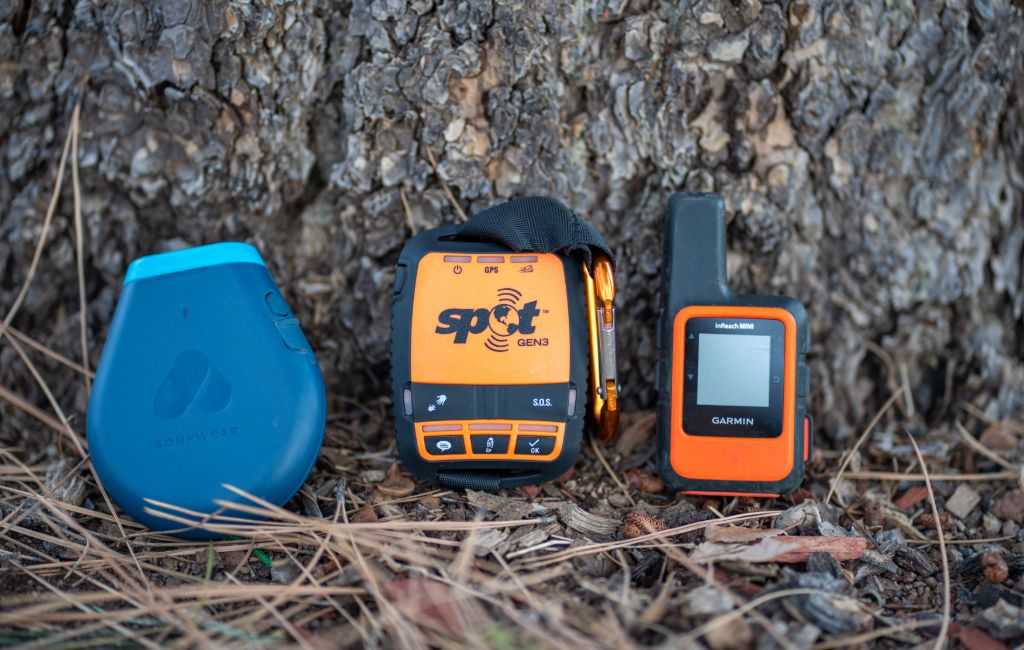
Best Personal Locator Beacons and Satellite Messengers
| Personal Locator Beacons | Weight | Price | Subscription |
|---|---|---|---|
| ACR ResQLink+ | 5.2 oz | $369.95 | N/A |
| McMurdo FAST FIND 220 | 5.4 oz | $257.31 | N/A |
| Ocean Signal RescueMe PLB1 | 4 oz | $309.95 | N/A |
| Satellite Messengers | Weight | Price | Subscription |
| Garmin InReach Mini | 3.5 oz | $339.90 | Annual & Monthly |
| Spot Gen3 | 4 oz | $229.95 | Annual & Monthly |
| Spot X | 7 oz | $249.95 | Annual & Monthly |
| ZOLEO Satellite Communicator | 5.3 oz | $199.99 | Monthly |
| Somewear Global Hotspot | 4.1 oz | $279.99 | Annual & Monthly |
| BivyStick | 3.3 oz | $199.95 | Annual & Monthly |
Personal Locator Beacons

ACR ResQLink+
Weight: 5.2 oz
Price: $369.95
Why we like it: It floats and has great attachment points.
The ResQLink/ResQlink+ is ACR's entry-level PLB for consumers. The ResQLink and ResQLink+ are identical except the ResQLink+ is buoyant, while the ResQLink is not. Both models have all the SAR functions you need -- GPS, 406MHz and 121.5MHZ, but lack some of the extras like a dedicated LED screen. The sub $300 price point and small size are the device's main selling points.

McMurdo FAST FIND 220
Weight: 5.4 oz
Price: $257.31
Why we like it: Most affordable PLB
The McMurdo FAST FIND 220 prides itself in being the least expensive PLB around, and with no subscription fees, it will quickly become the most cost-effective option for any SOS device. The device uses both the Galileo and GPS networks to create a faster and more cohesive pinpoint location when sending an SOS signal.
It’s waterproof to 10m so it can comfortably be used in land, sea, and air applications without having to worry about using any sort of waterproof case. We should note that the device itself does not float and will require that you use the included buoyancy pouch.
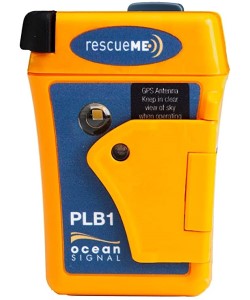
Ocean Signal RescueMe PLB1
Weight: 4 oz
Price: $309.95
Why we like it: World’s smallest PLB. The lightest PLB on our list.
If you are looking for the most compact PLB available, the Ocean Signal RescueMe PLB 1 is it. Barely thicker than a deck of cards it set the stage for small SOS devices. It’s so compact that it’s hard finding a reason not to bring it along.
As with most PLBs you will need to use the included buoyancy pouch with the device for it to float, but rest assured with a waterproof rating up to 15m, it is completely fine in the water.
Satellite Messengers

Garmin InReach Mini
Weight: 3.5 oz
Price: $339.90
Activation Fee: $29.95
Subscription plans:
$14.95 monthly
$11.95 annual
more here.
Why we like it: Most feature-rich in an ultralight package
The Garmin InReach Mini is a pint-sized version of the InReach satellite messenger. The smaller unit weighs a mere 4.23 ounces and comfortably fits in a pocket. You lose maps, but you keep the messaging, SOS, GPS, compass, and the mobile companion app of its bigger siblings.
It can send an SOS signal from the phone app when paired via Bluetooth. This device has a screen and multiple buttons to enable it to operate independently from a phone, too. Aside from the Spot X, this is the only other device that allows you to send messages without having your phone.
Read our in-depth review on the newer Garmin InReach Mini 2.

Spot Gen3
Weight: 4 oz
Price: $229.95
Activation Fee: $19.95 basic, $24.95 flex basic
Subscription plans:
$11.95/month - Basic
$14.95/month - Flex Basic
Why we like it: Most affordable device across the board
Spot is the primary competitor to the InReach in the satellite messenger world. The Spot Gen 3 device is smaller than the InReach and less expensive, but it lacks the two-way messaging of its competitor. Spot Gen 3 only offers one-way messaging that allows a user to send a message and not receive one. This device takes AAA batteries and is not rechargeable. It also does not have any navigational features.
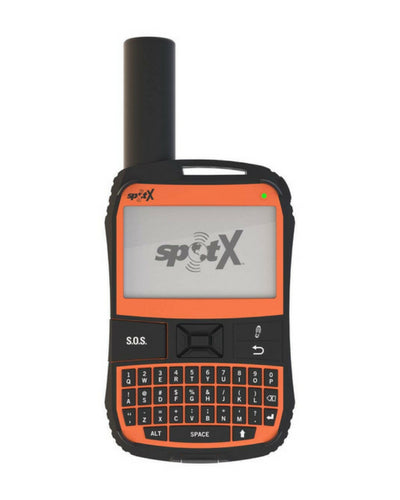
Spot X
Weight: 7 oz
Price: $249.95
Activation Fee: $19.95
Subscription plans:
$11.95/month - Basic
$19.95/month - Advanced
$29.95/month - Unlimited
Why we like it: The best for on-device messaging
Introduced in 2018, the Spot X adds a keyboard and brings two-way messaging to the service. It also has a backlit display and can tie into your Twitter and Facebook account for social media updates. The Spot X has a built in compass for navigation and passive location tracking and sharing.
Aside from the InReach Mini, this is the only other satellite messenger that can send messages without the use of a phone.
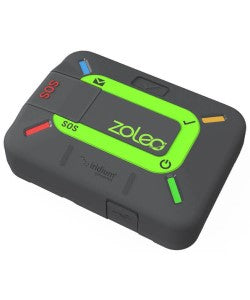
Zoleo Satellite Communicator
Weight: 5.3 oz
Price: $199.99
Activation Fee: $20
Subscription plans:
$20/month - 25 messages
$35/month - 250 messages
$50/month - unlimited messages
$6/month location sharing
$4/month to suspend plan
Why we like it: The best messaging service
Zoleo rethought satellite messaging when they released seamless messaging across Wi-Fi, cellular, and satellite signals. Keeping a chain of messages in one thread is very helpful, and for people looking to keep cohesive conversations going it is the clear winner.
Did we mention you can send messages with up to 950 characters if the recipient has the Zoleo App? You can also send an SOS signal from the phone app when paired via Bluetooth.
As the Zoleo doesn’t have a screen it can amp up the battery life to over 200 hours so you can head out for multiple days without needing a charge. It also allows you to share your location to a cellphone number as opposed to a website.
It doesn’t have any navigational features which some people may find a bit disappointing. However, using another app such as Gaia can quickly render than the problem.
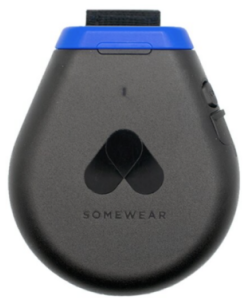
Somewear Global Hotspot
Weight: 4.1 oz
Price: $279.99
Activation Fee: $25 for first 2 plans, $35 for more expensive plans
Subscriptions Plans:
$8.33 monthly with annual contract- 10 messages or 75 tracking points
$15/month- 20 messages or 150 tracking points
$30/month- 75 messages or 600 tracking points
$50/month- unlimited messages and tracking points
$0 suspension fee for all plans $15 and up
Why we like it: The most affordable subscription plan
The SomeWear Global Hotspot is an excellent option for someone that wants the features of a satellite messenger without having to pay much in monthly fees. Starting at just over $8 a month for the basic plan it’s easy to justify the monthly subscription.
Along with Zoleo, the SomeWear Global Hotspot will thread all your messages together across Wi-Fi, cellular, and satellite networks. However, you need to pair it with your cellphone to be able to send messages.
As a side note, we don’t trust the strap on the back of the device so make sure you have a good pocket to store it in.
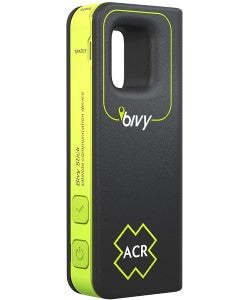
BivyStick
Weight: 3.3 oz
Price: $199.95
Activation Fee: $0.00
Subscriptions Plans:
$17.99 monthly / $14.99 annual - 20 messages, unlimited pre-set check-in messages
$29.99 monthly / $24.99 annual - 60 messages, unlimited pre-set check-in messages
$49.99 monthly / $44.99 annual - unlimited messages, unlimited pre-set check-in messages
Why we like it: Least expensive device and no subscription service plans
The BivyStick has recently undergone a massive upgrade and we think the newest version is a massive improvement. At only 3.3 oz it’s tied for weight with the InReach Mini, and with the functional hole in the middle of the device, it’s easy to toss a carabiner right through it.
You can send an SOS signal by either using the phone app when it is paired via Bluetooth or holding down the SOS button on the device for for 5 seconds. However, you need to pair it with your phone to be able to send messages.
The BivyStick also is great for someone only looking to use the device sporadically as there is no activation fee nor are you required to sign up for an annual subscription. The monthly fee is a bit more than some other plans but the ability to pick and choose which months you want is a huge money saver for intermittent users.
PLB Considerations
WEIGHT: 4-6 OUNCES
Personal Locator Beacons historically weigh substantially less than some satellite messengers, however with the growth of satellite messengers this discrepancy is shrinking. Most of the major PLBs weigh between 4 and 6 ounces.
PACKABILITY AND PORTABILITY
PLBs range in size, some being about the size of a deck of cards, to larger ones a bit smaller than bear spray. Either way, none of them comfortably fit into your pants pocket if you are on a long hike.
Instead, they will have a belt clip or attachment point for a carabiner so it can be immediately accessible in case of emergency. If you do decide to keep it in your bag, make sure it’s readily available.
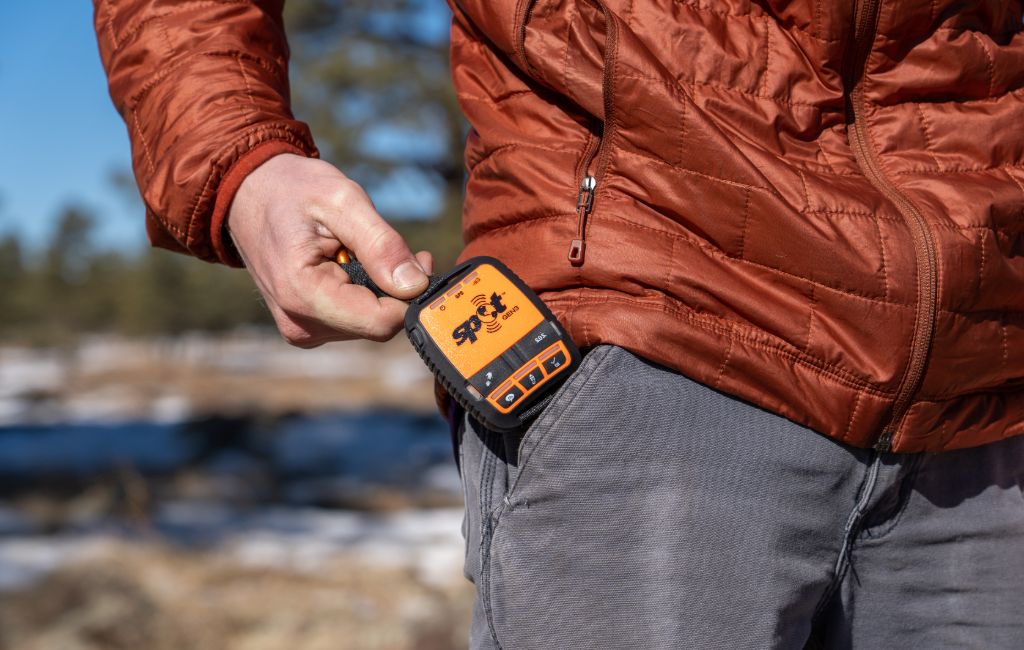
PRICE: $300 - $450
Prices vary from $300 to $450. There are a few differences that will affect the price, the first being the waterproof rating. While all are waterproof, more expensive models can be submerged deeper and for a longer duration.
Secondly, the buoyancy of the device, some will float while others will require a floating harness. Lastly, the networks they operate on will vary.
More expensive models will utilize more of the location networks, with the best models utilizing GPS, MEOSAR, and Galileo when sending the signal to the Cospas-Sarsat network. More location networks mean a faster and more precise location.
Price is affected by waterproof rating, ability to float, and the how many location networks it utilizes.
BATTERY: CLASS 1: 24HRS AT -20°F | CLASS 2: 24HRS AT -40°F
PLBs are sorted into two classes based upon their battery. Most consumer devices belong in the Class 2 category and have a battery that lasts 24 hours at -20°F (-28.9°C). A Class 1 PLB includes a heavy duty battery that can transmit for 24 hours at -40°F (-40°C).
WATERPROOF: WATERPROOF TO 10M WHEN NOT IN USE
All PLBs we reviewed are waterproof to at least 10m and exceed the IP68 when not in use. However, some devices will not have the same level of waterproofing when transmitting an SOS signal as an antenna will need to be deployed. Water will drastically interrupt signal transmission so be sure to keep it in a dry place if possible.
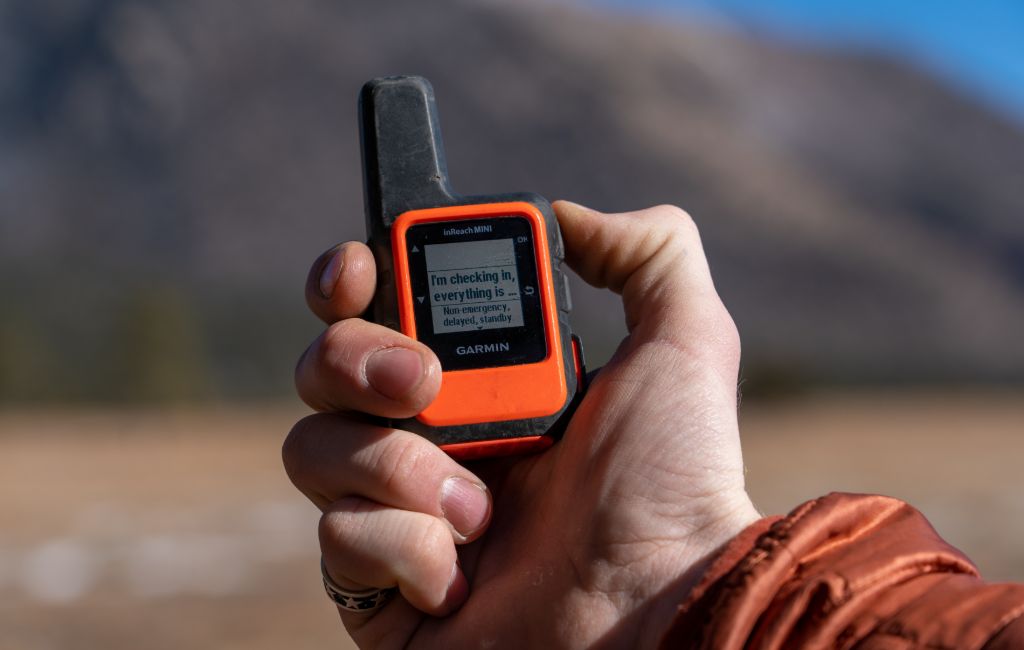
SOS ACTIVATION METHOD:
PLBs are incredibly straightforward to activate. Flip the protective cover, pull the antenna out, and press the button. All PLBs will require a clear view of the sky and a full extended antenna to reliably work. Some PLBs activate when they come into contact with water, but most of these are used exclusively in the marine industry.
Flip the protective cover, pull the antenna out, and press the button.
REGISTRATION: REGISTER YOUR DEVICE THROUGH NOAA
Prior to using your PLB, you are legally required to register it with your associated national body. In the United States, this is through NOAA. If any of your personal information changes, such as address or phone number you will be required to update this information.
Take note of where you purchase your device as they are coded for individual country registrations, for example, purchase your device in the US if you plan on registering it in the US. Once registered it can be used anywhere in the world.
Purchase your device in the same country that you're registering it in. Once registered, it can be used anywhere in the world.
FREQUENCY: 406 MHZ
If you have the older 121.5 MHz and 243 MHz PLBs they will no longer communicate with the satellites as they have all been replaced by the new 406 MHz PLBs.

EASE OF USE: ALL ARE SIMPLE TO OPERATE (1 TO 2 BUTTONS)
Most PLBs will only have 1 or 2 buttons on the entire device so they are very simple to operate. Every device will have an “activation” button to send the SOS signal, this button will always have a protective cover over it so you don’t accidentally trigger it.
Additionally, most will have a “test” button so you can make sure the device is working properly. There will be a sound, LED code, or message on the screen alerting you to the status of the test.
OTHER FEATURES:
While the ability to trigger an SOS is incredibly helpful, some devices also feature an LED that will flash an SOS code, which will help alert others in the area if they can see you. Once emergency rescue arrives it will also help them locate you if it’s dark out.
Satellite Messenger Considerations
WEIGHT: BETWEEN 4 AND 7 OUNCES
Satellite messengers have vastly decreased in weight over the past few years. All models we reviewed weigh between 4-7 ounces. There are a few models currently available that weigh between 8 and 16 ounces however they are the exception and are typically used inside a vehicle rather than out on the trail. The weight of devices has dropped so significantly that it’s very easy to justify bringing it along.
PACKABILITY AND PORTABILITY
The Packability of satellite messengers has greatly improved over the years. Almost all devices will have a strap that you can attach a carabiner to, or in the case of the BivyStick, you can clip right through the device.
In our experience, we would be particularly cautious with the attachment point on the Somewear device as it can easily break. If you don’t have a good place to attach the device, they are all small enough to fit inside a hip belt pocket, fanny pack, or the top lid of your pack.

PRICE: DEVICE PRICE: $200-$350 | ACTIVATION FEE: $20 - $40 | SUBSCRIPTION FEE: $11.95+ per month
Device Price: The price of satellite messengers varies, typically depending on how many features are available through the device, and what features are available using it as a standalone device without the necessity of using your phone. The devices start around $200 and top out around $600, for this review we focused on devices between $200 and $350 as we find they have the most common features people are looking for.
Devices at the entry-level price range tend to not have a screen or any buttons other than “power” and “SOS”, in contrast to more expensive messengers (like the InReach Mini) which have a screen, multiple buttons, and can be operated independently from a phone.
Activation Fees: These are relatively low, between $20 and $40, and are only paid when you initially register the device.
Subscription Fees: Subscription fees can vary widely, all devices will have 2 options for subscriptions: annual or monthly. Fees start at $11.95 a month for a small allotment of messages and climb upwards when you add in unlimited tracking and unlimited messaging.
With an annual subscription, you will pay a lower price per month and avoid supplemental fees. With most monthly plans you can pay only for the months you need but you will pay a premium for this flexibility through the monthly plan and typically with an extra annual fee.

BATTERY: LASTS A COUPLE OF DAYS TO A WEEK
The battery life on all satellite messengers depends on what features you have activated and your usage. Fortunately, most of the satellite messengers we reviewed have rechargeable lithium-ion batteries so if you are on an extended trip, you can use a battery bank to recharge the device.
With high-frequency tracking intervals and several messages per day, the charge will still last multiple days. With low-frequency tracking and only a couple of messages per day, the charge can last up to a week. Some devices take AAA batteries and do not have a rechargeable lithium option such as the SPOT Gen3.
WATERPROOFING: IPX7 OR IP68
All satellite messengers we have reviewed will come with a standard waterproof rating of IPX7, which means it can be submerged in water up to 1m. Some devices will bump this rating up to IP68 which allows the device to be submerged up to 1.5m.
For land-based activities, this will almost always be fine, however, if you are encountering river crossings ensure the device isn’t directly in the flow of water as the pressure can exceed the device's waterproof rating. If you will frequently be using the device in the water, we would suggest using a dry sack for protection.

SOS ACTIVATION METHOD
Activating the SOS on a satellite messenger is almost identical to PLBs however no antenna must be deployed. On almost all devices there will be a protective cover that flips up to reveal the SOS button. On the bivystick it is a button that must be held down for 5 seconds. The Zoleo, BivyStick, and Garmin devices allow you to send an SOS signal from the phone app if it is paired via Bluetooth, which allows a bit more freedom for where you store your device.
Lastly, a huge perk of 2-way satellite messaging devices is that they allow you to directly communicate with the emergency response team to update the changes to your location or status, or to let them know what the nature of the emergency is.
On almost all devices there will be a protective cover that flips up to reveal the SOS button. On some you can send an SOS signal from the phone app too if it is paired via Bluetooth.
EASE OF USE
Compared to PLBs, satellite messengers have a lot more features. Understanding how to use all these features effectively will inherently take a bit more familiarity. Fortunately, sending an SOS signal is always very straightforward and doesn’t require any additional steps compared with PLBs. In general, if you are comfortable with downloading and operating most phone apps, none of the features will be exceptionally challenging to operate.
With devices like the Spot X you do not need any additional device to send a message, with devices like the BivyStick, Somewear, and Zoleo, you will have to pair it with your phone. Each manufacturer will have its own associated app that will house all the features and allow you to use your phone's keyboard to compose messages.
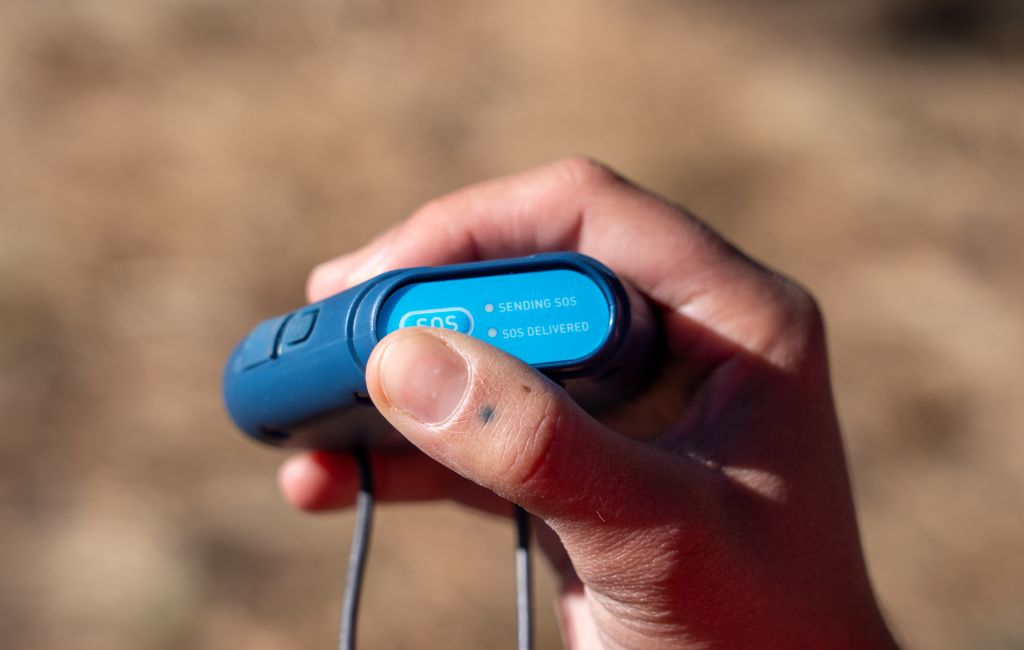
FEATURES
Weather reporting: Another great feature of satellite messengers is the availability to receive a weather forecast. This will typically use up one of your messages included in your plan but will provide a multi-day forecast based on your GPS location.
This service is very useful as you don’t have to rely on a person to respond as you would with a message, and you can use this forecast to make informed decisions about your route choice or what your plan looks like on a day-to-day basis. Spot devices do not offer weather reporting.
Smartphone Pairing: All models reviewed have a smartphone app that pairs via Bluetooth. Most devices will require the use of the app to send custom messages, but all of them will work as an SOS device without your phone.
If you do not want to bring your phone and want messaging services, there are devices that offer this (InReach Mini and Spot X). With the exception of the Spot X, all of the devices are primarily designed around pairing with a phone to use all of the features.
The manufacturers realize that almost everyone is going to bring a phone, so they create small devices that essentially use your phone as a remote and screen to save space, weight, and money.
Most devices require the use of their app to send custom messages while some don't have this requirement. All of them will work as an SOS device without your phone.
Two-way messaging: Besides the Spot Gen 3, all devices offer 2-way messaging. The Spot Gen 3 can only send messages. The Zoleo and Somewear offer seamless messaging, whether you have phone service, wifi, or using the satellite messaging service, these devices will link all your messages together into one thread within the app so you can have continuous conversations.
Additionally, Zoleo offers one final benefit over all the other devices, if the recipient also has the Zoleo app installed, your messages can include up to 950 characters rather than the standard 160 for SMS messages.
We should mention that some devices allow for pre-set messages, meaning you will have a few different options of predetermined texts to send to predetermined people. These typically will not use your allocated “custom messages” in your service plan but require you to set up these parameters while at home on the computer.
All devices offer 2-way messaging (besides the Spot Gen 3). Some devices allow you to pre-set messages so that you have different options of predetermined texts to send to predetermined people.
Network and signal coverage: There are 3 main networks for satellite messengers: GEOS which operates all SOS calls, Globalstar which operates Spot device messaging, and Iridium which operates all other messaging devices.
- GEOS has excellent coverage around the world and is second only to SARSAT which is the dedicated network for PLBs.
- Globalstar is the weakest network and reflects the more rudimentary messaging system of Spot devices. Until very recently Spot devices would not work in Australia, and their coverage can still be spotty in certain areas outside North America and Europe. Make sure to check the coverage before you head out on an international trip.
- Iridium network has great coverage, but response times may vary depending on how close the nearest satellite is.

Passive location tracking and sharing: All of the devices reviewed allow for some form of location tracking. Most will upload your track to a website where others can track your progress. Don’t worry, security settings can be enabled requiring a specific link and/or password to view the track.
This allows others to follow along on your journey, know where you are if you haven’t checked in, or see your last known location if you have gone missing. Devices will have a variety of timeframes balancing accuracy with battery usage.
The Zoleo recently received an update that allows you to share your location, however, it will be sent to a phone number rather than a website and is an additional subscription fee.
All reviewed devices allow for some form of location tracking. Most will upload your track to a website for selected others to see while some allow you to share your location to a phone number.
Navigational features: Almost all satellite messengers will have some navigational features, however, to truly harness their power you will need to use a phone. The Spot Gen 3 and Zoleo do not offer any navigation tools. Devices such as the InReach Mini and Spot X will have basic navigation tools such as a compass and programmable waypoints however they cannot be used to follow a breadcrumb trail or look at a map.
To use these features the devices must be paired with your phone. Using a phone, you can create routes, waypoints, look at a topographical map, and pretty much any other features standalone GPS devices will offer.
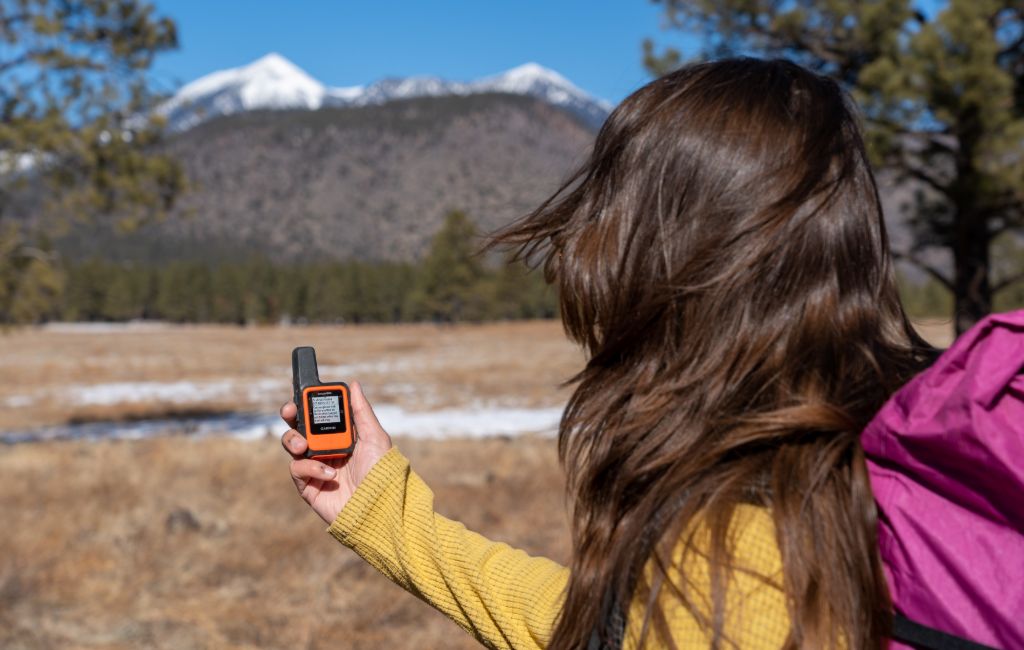
How do you carry a PLB and Satellite Messenger?
When bringing your PLB or Satellite Messenger, you should consider how you are going to carry it. It must be accessible and ideally within reach.
The most common way to carry it is with a carabiner around a loop on your backpack strap. For some larger devices, many people will put them in a hip belt pocket or a fanny pack. Devices that pair via Bluetooth can be out of reach but be sure that they have a clear view of the sky, so you have consistent reception.
Some examples of bad places to store the device are at the bottom of your pack, an unsecured outside pocket, or basically anywhere that it isn’t immediately accessible.
📷 Some of the photos in this post were taken by Jonathan Davis (@meowhikes)






 650-Calorie Fuel
650-Calorie Fuel


